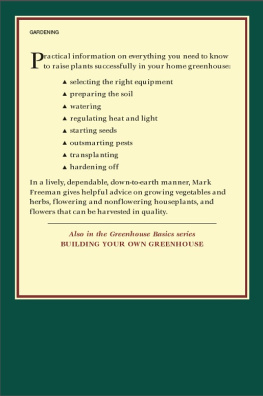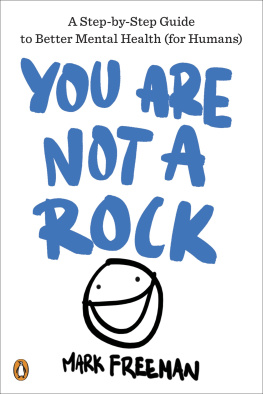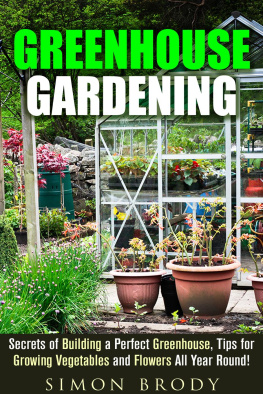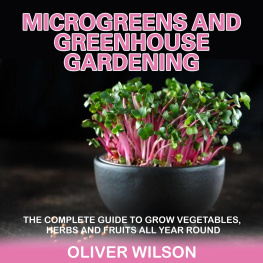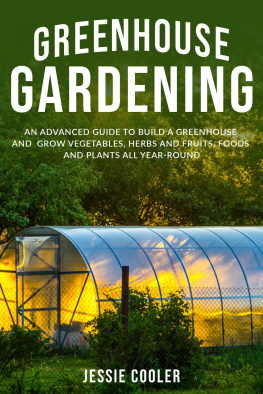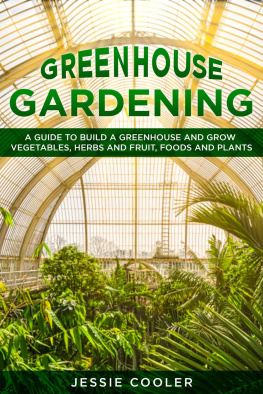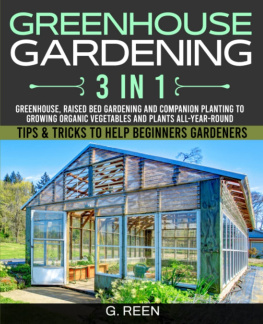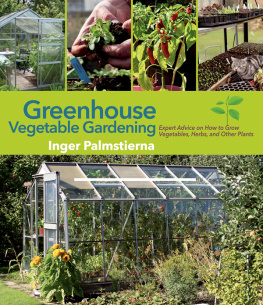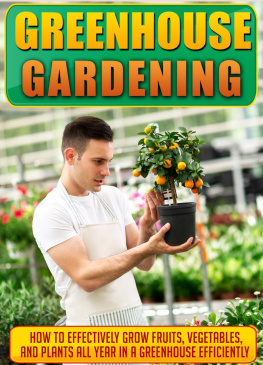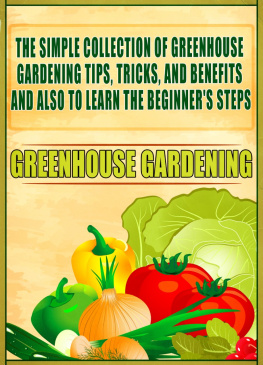Mark Freeman - Gardening in Your Greenhouse
Here you can read online Mark Freeman - Gardening in Your Greenhouse full text of the book (entire story) in english for free. Download pdf and epub, get meaning, cover and reviews about this ebook. year: 1998, publisher: Stackpole Books, genre: Children. Description of the work, (preface) as well as reviews are available. Best literature library LitArk.com created for fans of good reading and offers a wide selection of genres:
Romance novel
Science fiction
Adventure
Detective
Science
History
Home and family
Prose
Art
Politics
Computer
Non-fiction
Religion
Business
Children
Humor
Choose a favorite category and find really read worthwhile books. Enjoy immersion in the world of imagination, feel the emotions of the characters or learn something new for yourself, make an fascinating discovery.
- Book:Gardening in Your Greenhouse
- Author:
- Publisher:Stackpole Books
- Genre:
- Year:1998
- Rating:3 / 5
- Favourites:Add to favourites
- Your mark:
- 60
- 1
- 2
- 3
- 4
- 5
Gardening in Your Greenhouse: summary, description and annotation
We offer to read an annotation, description, summary or preface (depends on what the author of the book "Gardening in Your Greenhouse" wrote himself). If you haven't found the necessary information about the book — write in the comments, we will try to find it.
Gardening in Your Greenhouse — read online for free the complete book (whole text) full work
Below is the text of the book, divided by pages. System saving the place of the last page read, allows you to conveniently read the book "Gardening in Your Greenhouse" online for free, without having to search again every time where you left off. Put a bookmark, and you can go to the page where you finished reading at any time.
Font size:
Interval:
Bookmark:
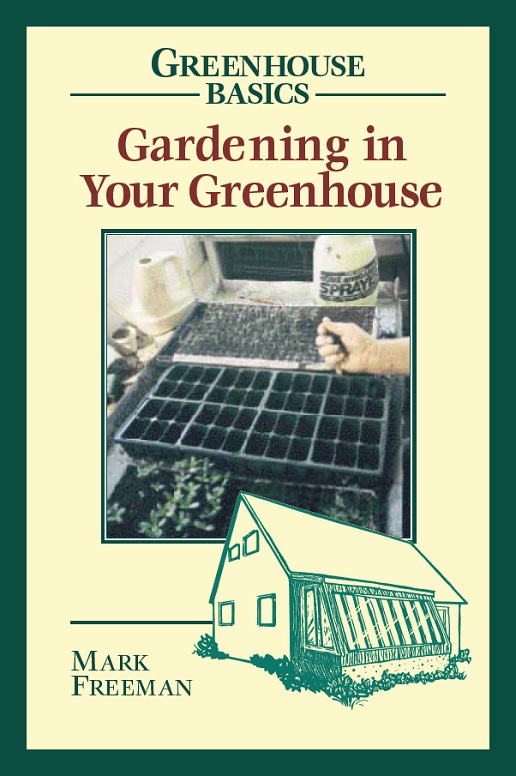

To Mary Louise Freeman-Lynde, better known as Molly, who has her great-grandmothers green thumb.
Copyright 1998 by Mark Freeman
Published by
STACKPOLE BOOKS
5067 Ritter Road
Mechanicsburg, PA 17055
www.stackpolebooks.com
All rights reserved, including the right to reproduce this book or portions thereof in any form or by any means, electronic or mechanical, including photocopying, recording, or by any information storage and retrieval system, without permission in writing from the publisher. All inquiries should be addressed to Stackpole Books, 5067 Ritter Road, Mechanicsburg, Pennsylvania 17055.
Printed in the United States of America
10 9 8 7 6
F IRST E DITION
Cover design by Wendy A. Reynolds
Cover line drawing by Heather Bellanca
Cover photo by Anne B. Freeman
Turf-Spray Home and Garden Sprayer Model 2501 inphotograph used with permission of Chapin Manufacturing, Inc.
The logos on the illustration onused with permission of Bentley Seeds Inc., Charles C. Hart Seed Co., and Shepherds Garden Seeds
Library of Congress Cataloging-in-Publication Data
Freeman, Mark, 1927
Gardening in your greenhouse / Mark Freeman ; illustrations by Heather Bellanca 1st ed.
p. cm. (Greenhouse basics)
Includes .
ISBN 0811727769
1. Greenhouse gardening. 2. Greenhouses. I. Title. II. Series: Freeman, Mark, 1927 Greenhouse basics.
SB415.F 74 1998
635.9'823dc21 98-4842
CIP
ISBN 978-0811727761
eBook ISBN: 9780811740531
Contents
Preface
I live and garden some thirty miles from Bennington, Vermont, at an elevation approximately 600 feet above sea level. The U.S. government says we are in Growing Zone 4; in general I agree. The average dates of last and first frosts here are May 10 and September 20, which gives us a growing season of 132 days. Our average annual percentage of possible sunshine is 53; in the three darkest months (November through January), we receive only 43 percent of possible sunshine.
In discussing greenhouse, and some outdoor, gardening conditions in this book, I have tried to allow for those who live in milder or harsher climates, but you may have to adjust some of my advice to make it applicable to your climate. To find out what zone you live in, check a good gardening encyclopedia; some seed catalogs also contain zone information.
To find out about your local insolation, which is the percentage of possible sunshine that you receive each month, see . A good almanac, like the Old Farmers Almanac, will tell you how many hours of sunlight are possible on any given day where you live, or at least at the nearest large city. If youve had a solar home or greenhouse for several years, you may already have a gut feeling for this; for example, weve known for years that its really dark here in November but that we get a lot of sunlight in February.
SOME NOTES ON STYLE
The editorial we used to have a purpose, in that it added some dignity to a piece of written work. Now, when every semieducated pro athlete and race car driver uses it, as in We are going to examine all our options before we decide to sign the contract, it cries out for the response Have you got a frog in your pocket? The author prefers the straightforward I. Where we is used in this book, it refers to some group of people, often but not always the author and his family.
I have found no good term in common use for home greenhouse owners. For this reason, I have coined the word greenhousers for those who own and work in a noncommercial greenhouse. It is a homely word, but it serves the purpose.
I have tried to use common names for plants in this book, with certain exceptions. In discussing vegetables, I use terms such as brassica and Solanaceae to avoid the vaguer terms cabbage types, which some might not know includes turnips, and tomato family, which also includes peppers and eggplants. I have given the Latin as well as the common names for all houseplants because they have a bewildering variety of common names. For example, what you may know as Patient Lucy somebody else calls Busy Lizzie. In many cases, such as coleus, the Latin name also is the common name.
All temperatures mentioned in this book are Fahrenheit. I have nothing against progress, but I have yet to meet a greenhouser in the United States who uses a Celsius thermometer, and a good many Canadians I know are just as comfortable with Fahrenheit as Celsius. If you arent, I apologize, but youll just have to use a conversion table.
If by any chance you are reading this book before constructing your own home greenhouse, I urge you to read the earlier book in this series, Greenhouse Basics: Building Your Own Greenhouse, because many of the ideas that follow work best in a greenhouse built according to the principles in that book.
I want to thank Laura McDermott, mentor of the Washington County Master Gardeners, and all the Master Gardeners who helped me with information and advice, especially Debbie Bailey. John Gail of Stokes Seeds provided a great deal of information about vegetable varieties for greenhouse growing, and Tim Kavanaugh of Rice Seeds helped me understand the seed industry in general and the problems of small seed companies in particular. Mike Taylor taught me a lot about houseplants and their use in large public buildings like hotels.
I could not have written this book, or anything else, without the help of my wife, Anne, who criticizes (in the true sense), corrects, proofreads, folds and staples, but does not mutilate, and is the worlds best speller.
Introduction
A lthough you wouldnt know it from the mass media, as we enter the twenty-first century the fastest-growing recreational activity in America may benot playing with a home computerbut gardening. Growing things in the backyard has always been a popular activity, and a necessity for some, but gardeners today are branching out into areas regarded as exotic by many a generation ago.
There are gardening books less than twenty-five years old that recommend the use of large quantities of DDT and other poisons as the solution to all pest problems. Today it is not necessary to identify oneself as an organic gardener; those who do not use compost and other natural fertilizers or who try to control pests and diseases with chemicals are now considered to be the oddballs, as organic gardeners were a quarter century ago.
In addition to practicing organic gardening, the majority of todays gardeners seek out plants and growing systems long considered exotic. Who today doesnt grow leeks and cilantro? Who doesnt know about raised beds and no-till systems? Herbs like rosemary and tarragon are common in home gardens; to be unusual today, you have to grow hyssop and lovage.
Granted, some home herb growing, like some organic gardening, is a fad, but there is a large core of determined gardeners who simply have found that herbs make food taste betterand may do at least as much for your health as the cold remedies and antacids found in drugstores. They like the taste of plum tomatoes and blue potatoes. They have found through trial and error that ladybugs control aphids better than malathion does and that cow manure is superior to 5105 from a factory. And theyre not about to go back to the old ways.
And then theres greenhousing. It began because many of us lived too far north to start tomatoes from seed outdoors or to eat lettuce out of the garden in December. We bought tomato and pansy plants at the local supermarket in the spring, tomatoes and lettuce at the same place in the winter. The taste of the produce didnt compare with what we grew ourselves, in season, and we discovered that what we ate, as well as the plants we bought to set out, had been liberally laced with chemicals. Besides, even the garden supply stores didnt sell Principe Borghese tomato plants, and the supermarket lacked arugula. (That last is only partly true today, when every small-town supermarket has exotic produce unknown to our parents, but we still dont know what its been sprayed with.)
Next pageFont size:
Interval:
Bookmark:
Similar books «Gardening in Your Greenhouse»
Look at similar books to Gardening in Your Greenhouse. We have selected literature similar in name and meaning in the hope of providing readers with more options to find new, interesting, not yet read works.
Discussion, reviews of the book Gardening in Your Greenhouse and just readers' own opinions. Leave your comments, write what you think about the work, its meaning or the main characters. Specify what exactly you liked and what you didn't like, and why you think so.

